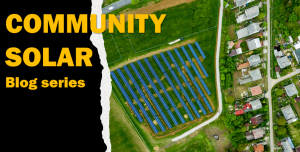Community Solar – Subscribing to Clean Energy
By David Comis, Senior Energy Program Manager
This is part two of a 7 part series on community solar.
Please note, the comments in this blog are the personal opinions of the author and do not represent the views of the Maryland Energy Administration or the State of Maryland.
Community solar arrays may be big (producing up to 2,000 kW of alternating current (AC) energy), or small (some as small as 10 kW units). Some consist of large ground mounted arrays, and some are simple rooftop arrays. In all cases the community solar arrays are owned by a company called a “subscriber organization”. Each subscriber organization must be approved by the Maryland Public Service Commission, which will then issue a 16 digit “subscriber organization number”. A subscriber organization is responsible for developing the solar array concept; working through all of the real estate, zoning, and permitting requirements; getting approval from the local electric utility to connect with the electric grid; and getting people or companies to subscribe for the energy that will be produced from the array. In some cases, subscriber organizations will contract with another company to find and sign up subscribers.
Subscriptions can come in two basic forms: an ownership model, or a power purchase agreement (PPA) model. Under the ownership model, the subscriber pays the subscriber organization a certain amount for each kilowatt of solar that they want (i.e.,. 10 kW). If the going price is $2,000/kW, then the subscriber will pay the subscriber organization $20,000 up front, but will then receive, at no additional cost, all of the electricity produced by those 10 kW of panels for the entire life of the array (which could be between 20 and 40 years). The other model (the PPA model) allows the subscriber to contract for a certain amount of electricity (again, let us say 10 kW), but the subscriber will pay nothing up front. Instead, the subscriber will pay at an agreed upon rate (say $0.10/kWh) each month for each unit of electricity produced by those 10 kW of solar panels. This month those 10 kW of panels may have produced 1,300 kWh so the subscriber would pay $130 for the electricity. The next month the panels might only produce 1,000 kWh, hence the subscriber would pay $100 for the month, and receive credit on their utility company electric bill for the 1,000 kWh produced that month.
So, what happens if the energy generated by the array exceeds the amount of electricity used by the individual subscriber during the month? As discussed in the last blog, Maryland allows for net energy metering. As such, any excess energy generated during the month will be banked and can be used to offset your energy bill for the succeeding months.
To date (as of July 24, 2020), all of the community solar projects built in Maryland have been subscribed using the Power Purchase Agreement model.


 1-888-373-7888
1-888-373-7888 233733
233733